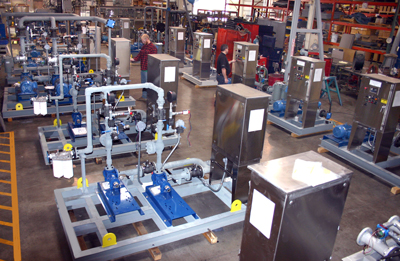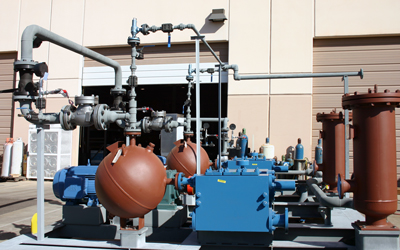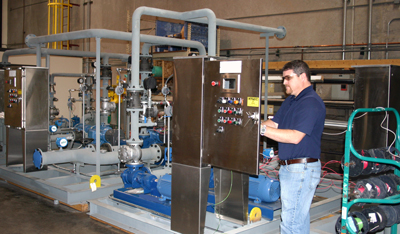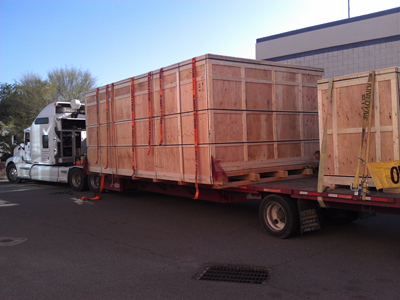Mining challenges occur regularly around the world. However, when they take place more than three miles high, they require strategic thinking coupled with smart solutions. At the end of the first quarter 2012, a pump and packaged system company, which fabricates and services mechanical systems that move fluids and gases for industrial applications, successfully completed a large project that involved the design, fabrication, testing and shipment of 18 customized pump packages for a new mine in South America.
The packages were constructed for the Toromocho mine site, which is located 4,600 meters in the Morococha mining district in central Peru. The project was a fast-paced fabrication challenge for the company’s engineers.
The principal challenges affecting construction at the job site were the extreme elevation and its remote location. These two factors led to the attractive option of pre-engineering the packaged pumping systems in a controlled environment where testing and quality control were easily managed.
 |
| Simplex and duplex systems during fabrication |
About the Mine
The Toromocho mine—owned by The Aluminum Corporation of China Ltd. (Chinalco) and managed through its subsidiary, Minera Chinalco Peru, S.A.—is a mining and ore processing facility located approximately 140 kilometers east of Lima, Peru. Once operational at full capacity, Toromocho, Chinalco's first major mining investment in South America, will become one of Peru's largest mining operations.
Toromocho is a large, open pit mine with ore reserves of 1,526 million tons. It is expected to produce 250,000 tons of copper annually. In addition, silver and molybdenum tri-oxide will be produced as a valuable byproduct.
The System's Components
In early 2011, the pump company was awarded the contract to build 18 complete pump packages. The packages will provide pumping solutions for fuel oil and reagent unloading and transfer and dispensing systems throughout the mine site. During the design phase, the engineers developed detailed bills of material, general arrangement (GA) drawings and made recommendations for accessories to ensure the overall reliability of each system. The final design was approved and the equipment released for manufacture in the third quarter of 2011, with final assembly beginning early in 2012.
The 18 unique packages were built on fabricated steel bases ranging in size from 1 meter by 1.25 meters to 4 by 7.5 meters and weights from 450 to 11,500 kilograms, respectively. None of the pump packages were identical. However, all the systems included pumps, motors, controls, valves and instrumentation, which was custom designed and built for their respective applications.
The largest pump package serves as a fuel oil transfer station, pumping diesel fuel. This pump station features two large 40-horsepower high-pressure plunger pumps rated for 20 cubic meters per hour at 4,100 kPa and two, smaller, three-horsepower, lower pressure rotary gear pumps rated for 15 cubic meters per hour at 120 kPa. The plunger pumps servicing the fuel oil requirements at the mine site included maintenance-free suction stabilizers and discharge pulsation dampeners.
Ten of the pump packages were a duplex pump and piping arrangement including rotary gear pumps with motors ranging from 1 to 15 horsepower. The remaining skids were a simplex design using either a rotary gear or sealless, magnetically driven centrifugal and diaphragm pumps.
In addition to application-specific pumps and motors, other system components included:
• Inlet duplex cartridge filters
• Pump isolation valves
• Discharge check valves
• Pressure relief valves
• Flow meters
• Gauges
• Low-flow/high-pressure switches for added pump protection

The quadraplex pump package prepared for crafting
The majority of the systems were fabricated using carbon steel due to the non-corrosive nature of the fuel oils and reagents. However, the caustic system incorporated an ethylene-tetrafluoroethylene-resin-lined ANSI magnetically driven process pump and an autoclave agitator flush system incorporating 316 stainless steel piping valves and accessories.
Each pump package included a common simplex, duplex or quadplex control panel designed specifically to either locally start and stop each pump or remotely control each pump from the central plant automation system (PAS).

Control panel testing
Due to the potential hazards associated with fuel oils—the application for which a majority of the pump packages will be installed—13 of the control panels were UL listed for Class 1, Division 2, Group C and D environments. The balance of the control panels will be located in non-hazardous locations throughout the plant. All the control panels incorporated NEMA 4X stainless steel enclosures; hand-off-automatic (H-O-A), push button, start/stop and emergency stop (E-STOP) switches; and a programmable logic controller (PLC).
In addition to individual component testing of pumps, motors, control panels and piping during manufacturing, each completely assembled system underwent a hydrostatic pressure test, a complete electrical test and a final quality assurance inspection prior to shipment.
Behind the scenes, this undertaking was orchestrated by an engineering, procurement and project management team dedicated to the successful completion of the project, which involved more than 100 purchase orders with 400 line items and 2,000 major assembly components. In addition, the vast project documentation requirements included all drawings, bills of materials, data sheets, test reports, spare parts lists, quality assurance documents and installation, operation and maintenance manuals (IOMs) in Spanish and English.
Each pump package was individually export crated and transported by four tractor trailers destined for the Port of Houston with a total combined weight of 40,000 kilograms and a total volume of 300 cubic meters.
The export crates make their way to Houston.
Summary
The pump packages were completed and shipped by the end of the first quarter of 2012 on schedule. Construction on the Toromocho mine was completed. Installation and start-up of the equipment began in late 2011. The Toromocho project was the largest fabrication effort to date for the pump company.


